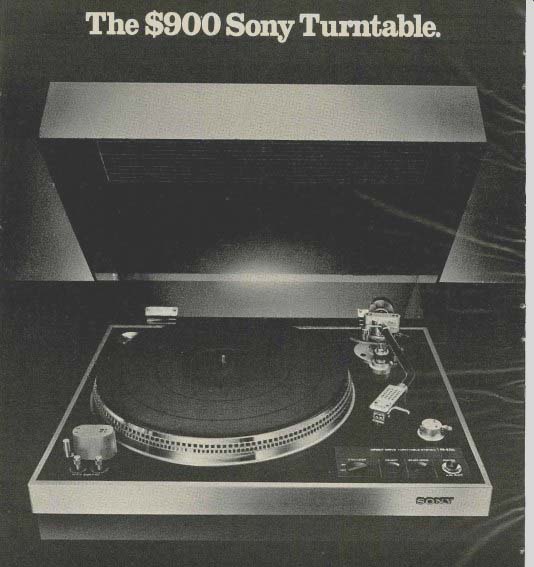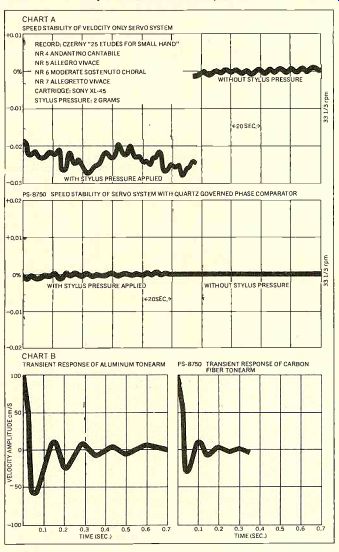
Study this page, because we don't want the price to suck you in.
It would be a shame.
People responding to something because it costs $900. Not because it's worth $900.
People captivated by price, not performance.
We at Sony don't want anyone spending good money for a great turntable for a bad reason like an impressive price tag.
Especially because there's so much technology in the PS-8750 for you to fall back on. After you spring for the $900.
So before you spend a lot of money on us, spend at least a little time with us.
Total speed accuracy is our speed.
Speed accuracy can be a problem for turntables because the stylus continually puts pressure on the record (and, in turn, on our engineers.) In fact, as little as one gram of stylus pressure can cause a slow down in record speed. A slow-down that is particularly noticeable in loud passages.
Up till now, most good turn tables achieved accuracy with a direct drive motor and a servo-system to control speed variations.
It was fine for most people. And it still is.
But for those with more elegantly attuned hearing, it's just not good enough.
That's because the servo-system will not serve when it comes to small, low-frequency speed variations. It is not sensitive enough, and the result is there to be heard- if you have the discernment to hear it.
To get around this, Sony took the conventional servo-system and revolutionized it by adding a quartz reference and a phase lock circuitry.
That mouthful is really easy to digest. The stable quartz generator emits a constant frequency. Any variations in speed monitored by the magnetic head are converted to changes in the phase of the signal.
This is, then compared against the quartz generator's phase signal.
If they do not match, our Xtal-Lock correct the speed variation instantly.
A conventional servo-system has to wait for the error to appear as a change in frequency, and then it takes time to correct it.
Sony can make the corrections 10 times faster. And within one cycle. All because Sony uses the phase difference as a source of information on speed error, rather than using the angular velocity.
Chart A dramatically illustrates the dramatic difference.
Cartridge sold separately.
----------- Why our tone-arm costs an arm and a leg.
After conquering the drive system, Sony sped along to the tone-arm. The problem: constructing a light, strong tone-arm that has a Now resonance quality.
A high resonance quality means the tone-arm vibrates-performing a duet with whatever record is playing.
Sony wrestled with the arm problem and came up with a different material: a carbon fiber of enormous strength and equally enormous lightness. Moreover, it has a much smaller resonance peak than the aluminum alloy commonly used. (See Chart B, where the difference is demonstrated:) The carbon fiber worked so well that it was even incorporated into the head shell of the PS-8750. But Sony didn't stop at the tonearm's construction. Next came the actual operation of it.
Mast turntables have one motor, operating both the drive system and the return mechanism. Meaning that the turntable is linked to the tone-arm. And very often, this linkage produces a drag on the arm.
The PS-8750, however, proves that two motors are better than one. The motor that runs the tone-arm is totally isolated from the other motor that runs the turntable.
This eliminates the drag, particularly the drag at the very end of the record.
This drag is really a drag, because the return mechanism is preparing to activate itself, and the friction is therefore increased.
Sony further innovates by designing pick-up and return cues that are optically activated. Like the doors in a supermarket, if you will.
With the PS-8750, you get the best of the direct drive manual and the best of the semi-automatic. With none of the worst of either.
Does your turntable give you bad vibrations? The same sound waves that travel from your speakers to your ears also travel to your turntable.
This transference excites the equipment. Becoming acoustic feedback, or IM distortion. And the louder you play your record, the more of it you get. There's cabinet resonance. Caused by sound waves.

And there's something called record resonance. Caused by the friction of the stylus in the groove of a warped record.
Sony, however, deals resonance a resounding blow.
We have built the PS-8750's turntable base of an inorganic material that is acoustically dead.
We have also undercoated the platter with an absorbing material that prevents it from transferring any bad vibrations to the good vibrations on the record.
And we cut down on record resonance by pumping a silicone damping material into the record mat itself. By having contact with the entire record surface, it offers more support.
Not for people who want the latest.
But the greatest.
The PS-8750 represents a tonnage of innovation and a couple of real breakthroughs.
It is not for those who want to spend $900 so they can say they spent it.
It is for those who want to spend $900 so they can hear they spent it.
Sony Corp. of America. Sony. 9 W. 57 St., N.Y. 10019. SONY is a trademark of Sony Corp.
Also see:
TAPE RECORDING--A professional shares his tips on how to do it right, JOHN WORAM